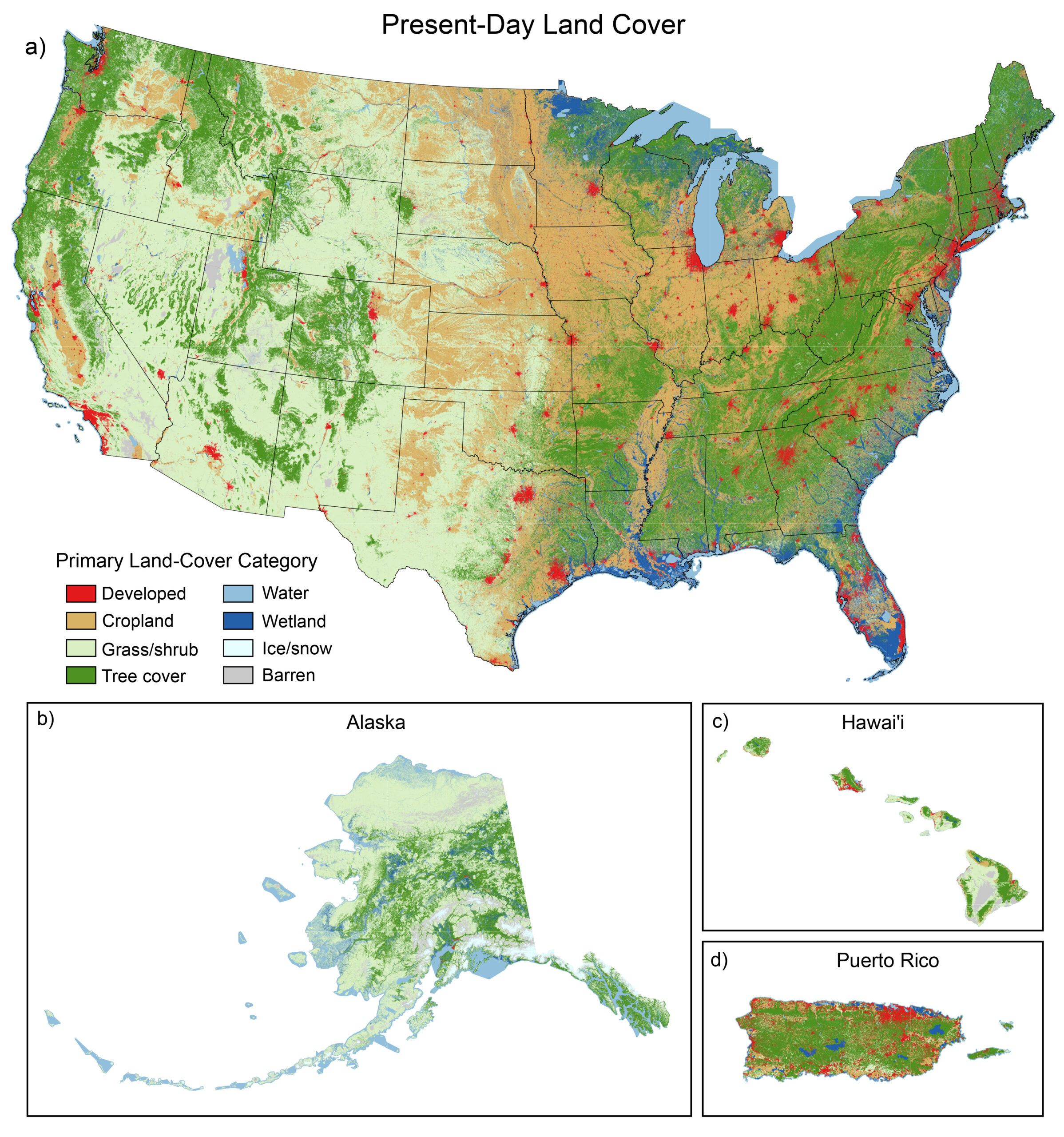
Climate Change Challenges and Solutions in Forestry & Agriculture
Climate change is already impacting agriculture and forestry production in the U.S. However, these sectors also hold the key to adaptation and mitigation. The United States Department of Agriculture (USDA) is at the forefront of addressing these challenges and developing solutions. Understanding the implications of climate change in agriculture and forestry is crucial for our nation to forge ahead with effective strategies and outcomes, ensuring our food and shelter resources remain secure.
Currently, the atmosphere contains more key greenhouse gasses (nitrous oxides, carbon dioxide, methane) than ever in history thanks to human activities. Industrial, agricultural, and deforestation practices add to the abundance of these critical gasses that are warming our planet. This has become more noticeable through more frequent severe weather and natural disasters with record heat waves, droughts, tornadoes, and rainfall. In 2023, global climate records of temperatures were broken and hit the highest in the last 174 years. Ocean temperatures are reaching record levels, along with major melts in ice sheets. All these changes will affect forestry and agriculture in profound ways. Crop damaging insects and diseases, along with other stresses caused by extreme changes, will also have cascading effects.
Adjustments or adaptations in response to climate change have progressed globally, with planning and implementation across multiple sectors and regions. While much attention is being paid to reforestation and reducing deforestation, gaps still exist and will need continued attention and financial input to address current and future challenges. Agriculture and forestry are two sectors worth exploring as they can open up climate adaptation and mitigation solutions that have positive cascading benefits across regions.
Challenges in the Agriculture and Forestry Sector
Agriculture contributes to greenhouse gas emissions through several activities, such as burning crop residues, soil management and fertilization, animal manure management, and rice cultivation. In addition, agriculture requires significant amounts of energy for vehicles, tractors, harvest, and irrigation equipment. Agriculture involves complex systems that include inputs of fertilizers and chemicals, management decisions, social factors, and interactions between climate and soil.
Most agriculture operations need fertilizers to produce goods, but the management and specific use of fertilizers need further focus. According to the Inventory of Greenhouse Gas Emissions and Sinks, agriculture contributes 9.4% of total greenhouse gas emissions in the United States.
Agriculture is particularly vulnerable to climate change because many operations are exposed to climatic changes in the natural landscape. There has been widespread economic damage in agriculture due to climate change. Individuals and farms have been affected by flooding, tornadoes, extreme wildfires, droughts, and excessive rains. Loss of property and income, human health, and food security is real for agriculture producers. Adverse impacts will continue to be felt in agricultural systems, particularly in crop production, water availability, animal health, and pests and diseases.
Forestry is a major industry in the U.S. and plays a key role in regulating the climate by transferring carbon within ecosystems and the atmosphere.. Forests remove carbon dioxide (CO2) from the atmosphere and store it in trees and soils. Forestry has seen a decline in the last few decades due to development and cropland expansion. The decline in forestry acres affects essential services such as air purification, regulating water quantity and quality, wood products for shelter, outdoor recreation, medicines, and wildlife habitat. Many Indigenous people and Tribal Nations depend on forest ecosystems for food, timber, culture, and traditions. Effective forest management is crucial for human well-being and is influenced by social and economic factors.

Land cover types and distribution of the United States. Forest lands have decreased in the last two decades. (Source: Fifth National Climate Assessment)
Forests are affected by climate change on local or regional levels based on climate conditions such as rainfall and temperature. The West has been significantly affected, with higher temperatures and drought leading to more wildfires. Higher temperatures come with higher evaporation rates, leading to drier forests that are susceptible to fires. The greater amount of dry wood causes extensive fires that burn more intensely. Fire activity is projected to increase with further warming and less rain. Since 1990, these extensive fires have produced greater greenhouse gas emissions of carbon dioxide (CO2). Other regions of the country with forests that typically receive more rain, like the southeast and northeast, are challenging to predict fire hazards. Other climate change effects include insects, diseases, and invasive species, which change forest ecosystems’ growth, death, and regeneration. Various degrees of disruption can impact a forest’s dynamics.
Current Adaptation Approaches in Agriculture and Forestry
Since agriculture’s largest contribution to greenhouse gas emissions is agriculture soil management, emphasis is being placed on reducing emissions from this process. Farmers are tilling less and using cover crops to keep the ground covered, which helps soils perform the important function of carbon storage. These techniques can also help lower soil temperatures and conserve moisture. In addition, those working in the agriculture sector are taking measures to adapt to the changing climate by developing crops that can withstand higher temperatures and water stress. Ecosystem-based solutions such as wetland restoration to reduce flooding have also been effective. Another potential solution is agroforestry, in which trees are planted, and other agricultural products are grown between the trees or livestock is grazed within a forestry system. This system provides shade to the animals and enhances biodiversity. It protects water bodies by keeping the soil covered with vegetation throughout the year. The perennial vegetation also stores carbon in above-ground vegetation and below-ground roots.
In the forestry space, land managers and owners are developing plans to adapt to climate challenges by building adaptations in key areas such as relationships and connections of land stewardship, research teamwork, and education curriculum. Several guides, assessments, and frameworks have been designed to help private forest owners, Tribal lands, and federally managed forests. Tribal adaptation plans also include Tribal values and cultural considerations for forests. The coasts will be adapting to more frequent flooding, and relocation of recreation areas in vulnerable areas is being planned. In major forestry production areas in the West, forestry agencies are developing plans for prescribed burning to keep dead wood lower, eliminate invasive species, and enable fire-adapted ecosystems to thrive, all while reducing severe wildfires. Thinning forests and fuel removal also help with reducing wildfire risk.
While both sectors have made progress in quickly adjusting their practices, much more needs to be done to ensure that land managers and affected communities are better prepared for both the short-term and long-term effects of climate change. The federal government, through USDA, can drive adaptation efforts to help these communities.
Current Policy
The USDA created the Climate Adaptation and Resilience Plan in response to Executive Order 14008, Tackling the Climate Crisis at Home and Abroad, which requires all federal agencies to develop climate adaptation plans in all public service aspects, including management, operations, missions, and programs.
The adaptation plan focuses on key threats to agriculture and forestry, such as:
- Outreach and education to promote the adoption and application of climate-smart strategies;
- Investments in soil and forest health to build resilience across landscapes;
- Building access to climate data at regional and local scales for USDA and stakeholders and leveraging USDA Climate Hubs to support USDA in delivering adaptation science, technology, and tools; and
- Increasing support and research for climate-smart practices and technologies to help producers and land managers.
Many USDA agencies have developed actions to address the impacts of climate change in different mission areas of USDA. These adaptation plans provide information for farmers, ranchers, forest owners, rural communities, trade and foreign affairs on ways to address the impact of climate change that affects them the most. For example, farm and ranch managers can use COMET Farm, a user-friendly online tool co-developed by Colorado State University and USDA that helps compare land management practices and account for carbon and greenhouse gas emissions.
USDA has invested $3.1 billion in Partnerships for Climate-Smart Commodities, encompassing 141 projects that involve small and underserved producers. The diverse projects are matched financially with non-federal funds and include over 20 tribal projects, 100 universities, including 30 minority-serving institutions, and others. The goals of the federal and private sector funding include:
- Developing markets and promote climate-smart commodities;
- Piloting cost-effective and innovative methods for understanding, monitoring, and reporting greenhouse gas emissions; and
- Providing technical and financial assistance to producers to implement climate-smart production practices such as reduced tillage and cover crops.
The USDA Forest Service has also developed its own Climate Adaptation Plan that comprehensively incorporates climate adaptation into its mission and operations. The Forest Service has cultivated partnerships with the Northwest Climate Hub, National Park Service, Bureau of Land Management, University of Washington, and the Climate Impacts Group to develop tools and data to help with decision-making, evaluations, and developing plans for implementation. One notable example is the Sustainability and Climate website, which provides information on adaptation, vulnerability assessments, carbon, and other aspects of land management.
Conclusion
While sustained government incentives can help drive adaptation efforts, it is important for everyone to play a role in adapting to climate change, especially in the agriculture and forestry sectors. Purchasing products that are grown sustainably and in climate-smart ways will help protect natural resources and support these communities. Understanding the significance of resilience against climate changes and disruptions is crucial, both in the short and long term. These challenges require collaborators to work together to creatively solve problems in addressing greenhouse gas contributions. Climate models can help solve complex problems and test different scenarios and solutions. As the Fifth National Climate Assessment of the United States notes, greenhouse gas concentrations are increasing, global warming is on the rise, and climate change is currently happening. The choices we make now can have a significant impact on our future.
The Federation of American Scientists values diversity of thought and believes that a range of perspectives — informed by evidence — is essential for discourse on scientific and societal issues. Contributors allow us to foster a broader and more inclusive conversation. We encourage constructive discussion around the topics we care about.
As people wait for this catastrophic grid failure to be remedied, much of southeast Texas, which includes Houston, is enduring dangerous, extreme heat with no air conditioning amid an ongoing heatwave.
The federal government plays a critical role in scaling up heat resilience interventions through research and development, regulations, standards, guidance, funding sources, and other policy levers. But what are the transformational policy opportunities for action?
Comprehensive heat safety standards are essential to mitigate the impacts of climate change on farmworkers and ensure the sustainability and resilience of agricultural operations.
Public deliberation, when performed well, can lead to more transparency, accountability to the public, and the emergence of ideas that would otherwise go unnoticed.